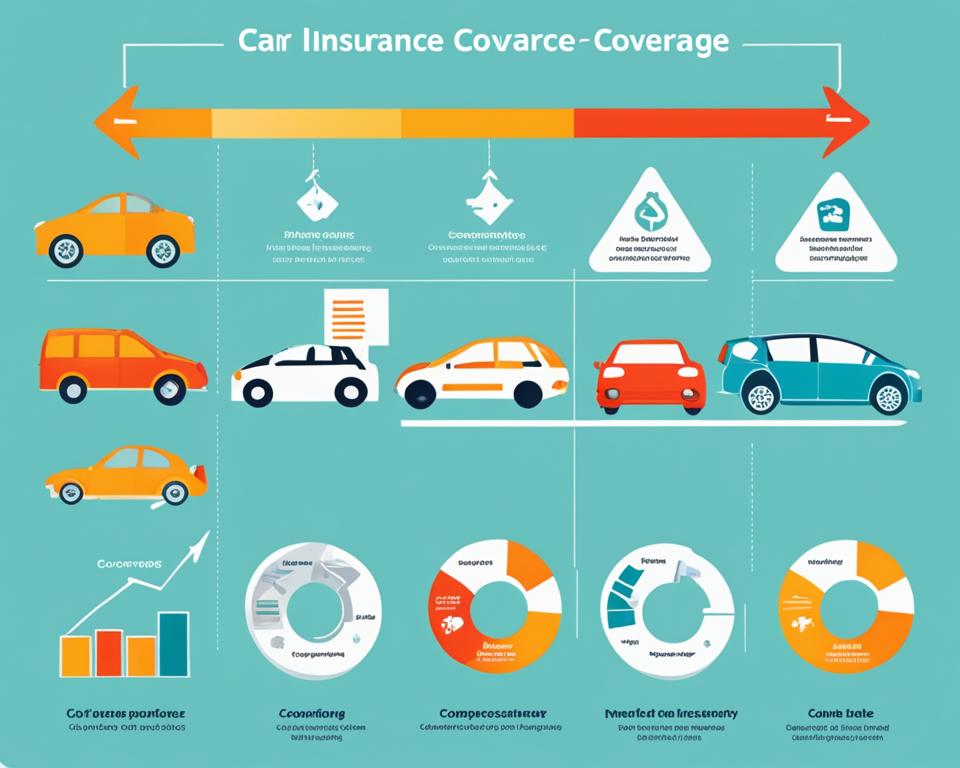In the complex world of the car insurance market, market dynamics continuously evolve, innovation spaces emerge, and the impact of technology continues to surge. Understanding these elements is key to grasping the nature of this industry. This comprehensive examination dives into the depths of these critical areas, shedding light on consumer behavior, innovative opportunities, technology implementation, and likewise, the tangible effects of legal and regulatory decisions on car insurance businesses. It’s designed to give you an in-depth understanding and situational awareness of the car insurance industry, whether you’re an industry professional, a policyholder, or simply an interested party.
Key Takeaways
- The car insurance industry is constantly evolving, driven by changes in consumer behavior, market dynamics, and technological advancements.
- Understanding consumer preferences, risk tolerance, and price sensitivity is crucial for insurance providers to design personalized and competitive offerings.
- Innovative solutions, such as unbundled policies, aggregated insurance marketplaces, and blockchain-powered transactions, present opportunities for industry disruption.
- Leveraging big data analytics, artificial intelligence, and emerging technologies can enhance the car insurance value chain, from risk assessment to claims processing.
- Legal and regulatory factors, including data privacy laws and liability shifts in the autonomous vehicle era, significantly impact the industry’s operations and product development.
Consumer Behavior and Market Dynamics
The landscape of the car insurance industry is undergoing rapid transformations, heralding a new era dominated by consumer behavior and market dynamics. In a market full of discerning customers with a wide array of variables to consider and compare, insurance providers must proactively gauge consumer insights and attitudes toward risk tolerance, price sensitivity, and loyalty.
Discerning Customers: Understanding Risk Tolerance, Price Sensitivity, and Loyalty
A deeper understanding of these dimensions arms companies with the skill to strategically navigate the business waters with agile business models and innovative service structures. Pioneer insurance providers are already harnessing the power of advanced analytics to study consumer patterns. Knowledge gleaned from such data has become a pivotal guiding force for aligning insurance solutions to the new breed of customers who desire personalization, flexibility, and transparency.
Adapting to Autonomous and Electric Vehicles: Shifting Risk Profiles
Prevailing market dynamics, such as an increase in autonomous and electric vehicles, incite further shifts in the risk profiles of insurance underwriting. Insurance providers that adapt swiftly by designing newer models of risk evaluation and pricing can secure a competitive edge.
Digitalization and Insurtech: Transforming the Value Chain
Moreover, the advent of digitalization and insurtech, inspired by evolving consumer preferences, is molding the industry’s value chain. Insurance apps that simplify policy purchase and claiming processes, usage-based insurance models, and telematics are just the tip of the innovation iceberg.
Innovation Opportunities
In this modern era where disruption is the key, the car insurance industry is ripe for innovation in several areas. One such area is Unbundling Auto Insurance Policies. Currently, most policies are ‘bundled’ – for instance, liability, collision, and comprehensive coverage are merged into one package. However, market trends show that customers appreciate the ability to tailor their insurance needs according to their specific circumstances. Unbundling auto insurance policies into various discrete options would allow consumer choice and truly personalized coverage – a sure-shot way to enhance customer satisfaction and retention.
Aggregation of Information: Auto Insurance Search Engines and Marketplaces
On the other hand, an aggregation of information is another potential bed for innovation. The availability and analysis of data are the engines driving the modern economy, and the auto insurance industry is no exception. Agreeably, we’ve seen how advanced analytics elevate the understanding of consumer patterns, but there’s so much more to harness. Imagine an auto insurance search engine or an online marketplace that collects data from a host of providers to tailor and offer the best available coverage to customers based on their specific criteria. This not only puts power back into consumers’ hands but immensely aids in making data-driven decisions.
Blockchain Technology: Enhancing Transparency and Efficiency
Furthermore, positive strides in blockchain technology necessitate its exploration within the motor insurance arena. Blockchain can provide an indisputable record of all transactions, claims, and contracts, thereby reducing fraud, enhancing administrative efficiency, and ensuring transparency – a characteristic much craved by consumers. Even better, by leveraging smart contracts, the processes can be automated leading to faster and more accurate claim settlements.

Technology Integration
The effective fusion of technology and the car insurance field is an equation that once solved, holds immense promise. There’s enormous potential, for instance, in leveraging Big Data to not only fine-tune the precision of risk assessment but also pivot into preemptive solutions.
Big Data Analytics: Preemptive Solutions and Risk Mitigation
Imagine a world where extensive data analysis helps insurers identify customers most likely to have an accident soon, thus enabling them to offer preemptive driving courses or suggest vehicle maintenance, potentially diminishing accident rates. This proactive approach brokered by data analysis could dramatically change the car insurance industry landscape, shifting it from reactive claims payout to preventive measures, saving lives, reducing costs, and boosting customer satisfaction simultaneously.
Artificial Intelligence (AI) and Machine Learning: Automating Claims Processing and Customer Profiling
Artificial Intelligence (AI) and machine learning also play significant roles in this technology-driven evolution. These technologies have the potential to expedite and automate the claims process — traditionally a substantial bottleneck. AI can analyze claim data swiftly and accurately, identifying potentially fraudulent cases and expediting legitimate ones, resulting in swifter payouts and greater customer satisfaction. Furthermore, machine-learning algorithms enable detailed customer profiling, offering highly tailored policies that match individual needs. This dynamic shift towards personalization could significantly enhance the customer experience while streamlining and refining the insurer’s risk.
Augmented Reality (AR), Virtual Reality (VR), and Internet of Things (IoT): Mixed Reality Experiences
In the grander scheme of things, these technological advancements in the car insurance industry are but the tip of the iceberg. Looking into the future, forward-thinking companies must embrace the adoption of a mixed reality environment, utilizing technologies such as Augmented Reality (AR), Virtual Reality (VR), and the Internet of Things (IoT). AR can assist in assessing vehicular damage, VR can provide immersive customer service experiences or simulate driving conditions for risk analysis, and IoT enables real-time tracking for usage-based insurance. The implementation of such technologies can potentially revolutionize the car insurance industry, creating an enviable competitive edge for businesses willing to delve into these uncharted waters.
Regulatory Landscape
As the car insurance industry undergoes a profound transformation, guided by consumer behavior and technological advancements, the regulatory landscape plays a pivotal role in shaping its future. At the intersection of data-driven innovations and insurance practices, we must navigate the intricate web of legal frameworks and compliance challenges to ensure sustainable growth and customer trust.
Data Privacy and Insurance Claim Laws: Compliance Challenges
With the increasing reliance on data and technology in the car insurance industry, the need to uphold robust data privacy protocols has never been more paramount. Understanding and adhering to diverse global and regional regulations around data protection, such as the General Data Protection Regulation (GDPR) and the California Consumer Privacy Act (CCPA), is crucial. The gathering, utilization, and storage of sensitive customer information, especially in telematics and AI-powered applications, must be consent-based, anonymized, and securely maintained to safeguard individual privacy. Additionally, the regulations governing insurance claim processes, from processing timelines to fraud management, are essential to maintaining compliance and delivering a seamless customer experience.
Autonomous Vehicle Insurance: Liability Shifts and Legal Adaptations
The advent of autonomous vehicles has ushered in a seismic shift in the car insurance landscape, with the traditional liability models facing a critical evolution. Historically, car insurance has been predominantly a liability-based model, holding the driver accountable for accidents. However, as autonomous cars gain widespread adoption, the epicenter of liability could potentially transition from the driver to the manufacturer or the software provider responsible for the vehicle’s autonomous systems. Navigating the complex legal and regulatory frameworks surrounding autonomous vehicle insurance, including liability determinations and coverage mandates, is a pivotal challenge for insurers and policymakers alike.
Novel Products and Pricing Models: Regulatory Approval Process
The car insurance industry is witnessing a surge of innovation, from pay-per-use models to policies that incorporate behavioral factors and usage-based pricing. As insurers explore these novel product designs and pricing strategies, the regulatory approval process becomes a critical consideration. Obtaining the necessary clearance to introduce these innovative offerings to the market is essential, not only for asserting their legality but also for ensuring their long-term viability and customer acceptance. Maintaining a proactive dialogue with regulatory authorities and staying abreast of evolving guidelines can help insurers navigate this dynamic landscape and deliver cutting-edge solutions that meet the evolving needs of today’s discerning drivers.

Car Insurance Insights
As we navigate the ever-evolving landscape of the car insurance industry, it’s crucial to stay informed and attuned to the latest trends and developments. From shifting consumer preferences to the impact of technological advancements, the car insurance sector is undergoing a profound transformation that holds immense implications for both providers and policyholders.
A deep dive into car insurance insights reveals the intricate interplay between market dynamics, innovation, and regulatory forces. By understanding these key elements, we can better navigate the complexities of the industry and make informed decisions that align with our unique needs and preferences.
One of the cornerstones of this industry evolution is the increasing prominence of auto policy analysis and vehicle coverage trends. As consumer expectations evolve, insurers are compelled to re-evaluate their product offerings, pricing structures, and customer engagement strategies. The rise of driving risk assessment and accident data analytics has enabled more personalized and proactive approaches to risk management, empowering both insurers and policyholders.
Furthermore, the integration of cutting-edge technologies, such as telematics monitoring and claims processing automation, has transformed the industry’s operational landscape. By harnessing the power of policyholder profiling and usage-based insurance modeling, insurers can now tailor their auto policy rates and vehicle coverage costs to individual driving behaviors and risk profiles.
As we delve deeper into the realm of car insurance, we must also consider the evolving driving risk factors and claims history analysis. These insights not only inform insurers’ underwriting decisions but also enable the development of innovative premium optimization strategies and premium discounts that empower consumers.
Ultimately, the car insurance industry’s journey is one of continuous adaptation, where deductible options, liability protection, collision coverage, and roadside assistance remain essential components of a comprehensive, customer-centric approach. By staying attuned to these car insurance insights, we can navigate this dynamic landscape with confidence and make the most informed choices for our unique needs and circumstances.
Finding the Right Coverage Options
Navigating the roadways of College Park, Georgia, comes with its own set of challenges and opportunities. From the bustling traffic near Hartsfield-Jackson Atlanta International Airport to the serene drives along Charles E. Phillips Esplanade, each journey is unique, much like the insurance needs of our diverse community of drivers.
Liability Coverage: Protecting Against Damages and Injuries
Liability coverage is the cornerstone of any car insurance policy and a legal requirement in Georgia. It covers the costs incurred due to damages or injuries you cause to others in an accident. Liability coverage is bifurcated into Bodily Injury Liability (BIL), which covers medical expenses, loss of income, or funeral costs of other parties injured in an accident where you are at fault, and Property Damage Liability (PDL), which takes care of the repair or replacement costs of other parties’ property or vehicles damaged in an accident you cause.
Collision Coverage: Repair and Replacement Costs After an Accident
Collision coverage swoops in to cover the repair or replacement costs of your vehicle following an accident, regardless of who is at fault.
Comprehensive Coverage: Protection from Non-Collision Events
Comprehensive coverage is designed to provide a safety net for those unforeseen occurrences. It covers the costs of damages to your car resulting from events other than collisions, such as vandalism, theft, fire, natural disasters, and animal damages.

Comparing Car Insurance Quotes
Navigating through the maze of car insurance rates can initially seem daunting, but with a pinch of local insight, you can better understand the lay of the land. Here, we delve into the average costs of car insurance in College Park, GA, and the myriad factors that influence these rates, aiming to provide you with a clearer roadmap to making informed insurance decisions.
Scope of Coverage: Liability, Collision, Comprehensive, and More
Diving into the realm of car insurance coverage unveils a spectrum of protection avenues. It’s about tailoring a policy that resonates with your driving habits, the value of your vehicle, and the level of financial security you seek on the thoroughfares of College Park, GA. Different insurance providers offer varying scopes of coverage. Assess whether the quotes encompass liability, collision, comprehensive, medical payments, or uninsured/underinsured motorist coverage as per your needs.
Policy Limits and Exclusions: Understanding Your Protection Level
Examine the limits on each coverage type within the quotes. Higher limits provide more protection but also come at a higher premium cost. Understand what is not covered under each policy, as exclusions can significantly affect your level of protection.
Deductible Options: Balancing Premiums and Out-of-Pocket Costs
The deductible is the amount you’ll pay out of pocket before your insurance kicks in. Lower deductibles typically result in higher premiums and vice versa. Check if the insurance provider offers a range of deductible options, allowing you to tailor the policy to your financial circumstances.
Discounts and Eligibility: Maximizing Savings Opportunities
Explore the discounts available and whether you qualify for them, as insurers often provide discounts for various reasons such as a clean driving record, bundling policies, or installing safety features in your vehicle.
Strategies for Saving Money on Car Insurance
To effectively navigate the landscape of car insurance and secure the best possible rates, it’s crucial to adopt a strategic approach when shopping for and comparing different insurance providers. This process involves a series of steps designed to ensure you’re well-informed and equipped to make decisions that align with your financial and coverage needs.
Shopping and Comparing Different Insurance Providers
Exploring the diverse offerings from various car insurance companies can lead to significant savings. Comparing quotes, coverage levels, and customer service ratings will help you identify the most suitable and cost-effective policy for your needs.
Considering Higher Deductibles: The Risk-Reward Trade-off
Raising your deductible is a strategic move that can lead to significant savings on your car insurance premiums. A deductible is the amount you’re responsible for paying out of pocket before your insurance coverage kicks in after an accident. By choosing a higher deductible, you’re taking on more financial responsibility, which in turn lowers your insurance costs.
Exploring Discounts: Bundling, Usage-Based, Safety, and More
Exploring the variety of discounts offered by insurance companies can significantly reduce the cost of car insurance. By understanding and applying for these discounts, policyholders can enjoy substantial savings. Bundling Policies, Maintaining Continuous Coverage, Telematics Devices, Driver Safety Courses, Anti-Theft Devices, Safety Features, Multi-Vehicle Discounts, Customer Loyalty, Pay in Full, AutoPay and Paperless Billing, Military, Student, and Senior Discounts, Affiliation Discounts, Good Driver and Accident-Free Discounts, and Special Discounts in California are some of the common discounts to look for.
Maintaining a Good Credit Score: Impacting Insurance Rates
Maintaining a good credit score is crucial for securing favorable car insurance rates. Insurance companies often use credit-based insurance scores to assess risk, making it essential for drivers to maintain a strong credit profile.

Personalized Car Insurance Solutions
In the ever-evolving landscape of the car insurance industry, the quest for personalized solutions is gaining momentum. We recognize that each driver’s needs and circumstances are unique, and a one-size-fits-all approach simply doesn’t suffice. That’s why we’re committed to empowering our customers with car insurance insights, auto policy analysis, and tailored coverage options that truly resonate with their driving profiles and financial requirements.
By leveraging advanced vehicle coverage trends and driving risk assessment analytics, we can provide our customers with a comprehensive understanding of their individual risk profiles. This data-driven approach allows us to craft premium optimization strategies and claims processing automation solutions that not only protect our policyholders but also offer policyholder profiling and usage-based insurance modeling to enhance their overall experience.
| Coverage Type | Auto Policy Rates | Vehicle Coverage Costs | Driving Risk Factors | Claims History Analysis |
|---|---|---|---|---|
| Liability Protection | $900 – $1,500 | $400 – $800 | Accident history, age, location | Frequency, severity, fault |
| Collision Coverage | $500 – $1,200 | $800 – $1,500 | Vehicle make/model, age, usage | Repair costs, replacement value |
| Comprehensive Coverage | $300 – $800 | $400 – $1,000 | Geographic location, theft/vandalism risk | Theft, fire, weather-related claims |
Our commitment to personalized solutions extends beyond just the coverage options. We also provide a host of premium discounts, deductible options, and flexible payment plans to ensure our customers can find the perfect balance between their auto policy rates and their financial well-being.
“At our company, we understand that car insurance is not a one-size-fits-all proposition. That’s why we’ve made it our mission to deliver car insurance insights and tailor-made solutions that cater to the unique needs of each and every driver.”
By embracing this customer-centric approach, we aim to revolutionize the car insurance industry, empowering our policyholders to make informed decisions and enjoy the peace of mind they deserve as they navigate the roads of their communities.

Conclusion
Through this comprehensive exploration, we’ve uncovered critical car insurance insights, delving into the vital role of consumer behavior and market dynamics, the immense potential of innovation and technology, and the crucial realm of legal and regulatory challenges facing the industry. Our aim has been to impart an informed perspective that empowers you to make well-rounded decisions when navigating the auto policy analysis and vehicle coverage trends.
However, this is an ever-evolving landscape, and continuous learning and adaptation are key. As the market shifts, driving risk assessment and accident data analytics advance, and the regulatory landscape transforms, so too must our understanding and response to these changes. By staying ahead of the curve and making informed decisions, we can optimize premium optimization strategies, harness the power of telematics monitoring and claims processing automation, and deliver personalized policyholder profiling and usage-based insurance modeling.
The car insurance industry is a dynamic and complex ecosystem, but by embracing the insights and opportunities presented here, we can navigate the auto policy rates, vehicle coverage costs, driving risk factors, and claims history analysis with confidence. Armed with an understanding of premium discounts, deductible options, liability protection, collision coverage, and roadside assistance, we can make informed choices that safeguard our financial security and provide the necessary coverage for the journeys that lie ahead.
FAQ
What are the key insights into the car insurance industry?
What are the major innovation opportunities in the car insurance industry?
How is technology transforming the car insurance industry?
What are the key regulatory considerations for the car insurance industry?
What are the essential coverage options in car insurance?
How can I find the best car insurance quotes and coverage options?
What strategies can I use to save money on car insurance?
Source Links
- https://www.insuringoklahoma.com/revolutionizing-the-car-insurance-market/
- https://peachyinsurance.com/car-insurance-quotes-in-college-park-ga/
- https://thedailyinsurance.online/mastering-car-insurance-a-guide-to-saving-more-money-in-2024/
